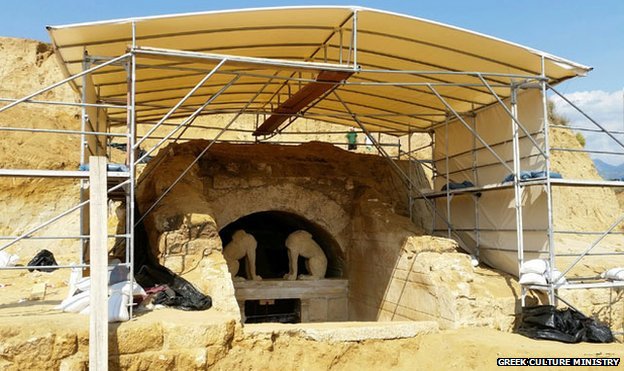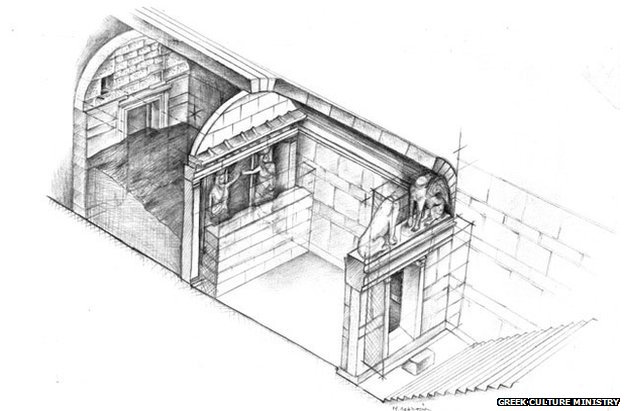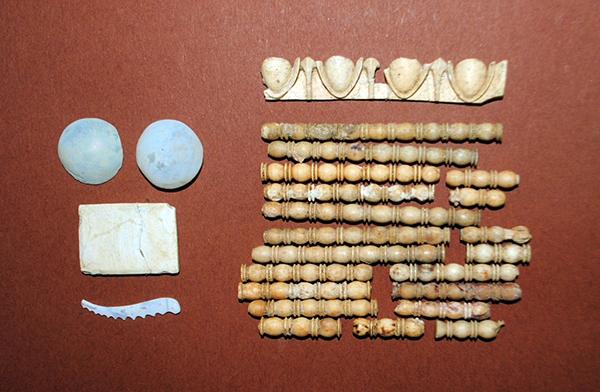It looks like you're using an Ad Blocker.
Please white-list or disable AboveTopSecret.com in your ad-blocking tool.
Thank you.
Some features of ATS will be disabled while you continue to use an ad-blocker.
21
share:
The Amphipolis tomb has been the site of one fascinating discovery after another this year but what has been conspicuously missing are any human
remains. This has led to speculation that the tomb, the largest ancient burial site in Greece, might be a
cenotaph, an empty tomb constructed as a monument to an a person whose remains were interred
elsewhere. Another hypothesis was that perhaps
British soldiers had looted the remains from the tomb in 1916.
 Tomb entrance guarded by a pair of sphinxes. Image credit: Greek Culture Ministry
Tomb entrance guarded by a pair of sphinxes. Image credit: Greek Culture Ministry
Now archaeologists can put the speculation to rest as a wooden coffin containing human remains has been found in a limestone crypt buried about 5 feet below the floor of the third chamber.
 Newly discovered beneath the floor of the third chamber. Image credit: Greek Culture Ministry
Newly discovered beneath the floor of the third chamber. Image credit: Greek Culture Ministry
From BBC:
 Sketch showing first two chambers. Entrance to 2nd chamber was flanked by two
caryatids. Image credit: Greek Culture Ministry
Sketch showing first two chambers. Entrance to 2nd chamber was flanked by two
caryatids. Image credit: Greek Culture Ministry
The dimensions of the limestone crypt are 3.23m x 1.56m x 1.8m (10.6' x 5.12' x 5.9'). Along with the wooden coffin, bronze and iron nails, bone and glass fragments were found. These are believed to have been ornament from the wooden casket.
 Artifacts presumed to be ornamentation from the casket. Image credit: Greek Culture Ministry
Artifacts presumed to be ornamentation from the casket. Image credit: Greek Culture Ministry
Examinations of the remains will hopefully shed some light on the identity of this undoubtedly important person! The tomb has been quite a hot news topic with all of the discoveries in recent months and there are 20 or so additional links here on my feed.

Now archaeologists can put the speculation to rest as a wooden coffin containing human remains has been found in a limestone crypt buried about 5 feet below the floor of the third chamber.

From BBC:
The culture ministry said the almost intact skeleton belonged to a "distinguished public figure", given the tomb's dimensions and lavishness.
Chief archaeologist Katerina Peristeri said "the tomb in all probability belongs to a male and a general".
"It is an extremely expensive construction, one that no single private citizen could have funded," the ministry said at a briefing for reporters on Wednesday. "It is in all probability a monument to a mortal who was worshipped by his society at the time."
Speculation has been rife, with experts raising several possibilities including the deceased being a member of Alexander the Great of Macedon's family or one of his most senior officials.

The dimensions of the limestone crypt are 3.23m x 1.56m x 1.8m (10.6' x 5.12' x 5.9'). Along with the wooden coffin, bronze and iron nails, bone and glass fragments were found. These are believed to have been ornament from the wooden casket.

Examinations of the remains will hopefully shed some light on the identity of this undoubtedly important person! The tomb has been quite a hot news topic with all of the discoveries in recent months and there are 20 or so additional links here on my feed.
edit on 2014-11-12 by theantediluvian because: (no reason given)
I'm giving this thread a well deserved bump. Interesting find I can't wait to see some video or pics. I'm very interested in the DNA analysis.
a reply to: SLAYER69
I thought it was a pretty big deal and I'll be excited to find out who is buried there. It doesn't sound like it's a woman or a child so that rules out Olympias, Roxana, and Alexander IV (assassinated at age 12). I don't think his presumed illegitimate son Heracles (assassinated at 18) would have warranted a tomb of this magnitude. If it's one of Alexander's generals/successors, I'd guess Cassander.
I thought it was a pretty big deal and I'll be excited to find out who is buried there. It doesn't sound like it's a woman or a child so that rules out Olympias, Roxana, and Alexander IV (assassinated at age 12). I don't think his presumed illegitimate son Heracles (assassinated at 18) would have warranted a tomb of this magnitude. If it's one of Alexander's generals/successors, I'd guess Cassander.
That place is amazing. Thanks for this. I seem to recall this is where Alexander's father was interred?
a reply to: nukedog
Philip II was buried in Vergina. There's good forensic evidence that a tomb found there in 1977 is his. There have been several possibilities suggested for who is buried in this tomb. From the sounds of things, the list just considerably shorter since the mostly intact skeleton appears to be an adult man. There was a skull fragment from the tomb in Vergina that was forensically tied to Philip II due to what appeared to be damage to the right eye consistent with Philip II's. Still, there are some who weren't convinced so his name has been tossed into the hat.
Philip II was buried in Vergina. There's good forensic evidence that a tomb found there in 1977 is his. There have been several possibilities suggested for who is buried in this tomb. From the sounds of things, the list just considerably shorter since the mostly intact skeleton appears to be an adult man. There was a skull fragment from the tomb in Vergina that was forensically tied to Philip II due to what appeared to be damage to the right eye consistent with Philip II's. Still, there are some who weren't convinced so his name has been tossed into the hat.
a reply to: theantediluvian
Ah I see. I just remember hearing about the lions in front of the tomb and I thought this was it.
Very intriguing. This has to be somebody in our history books. Let's see, Macedonia was "barbarian" country before Phillip II. Phillip II built the army and culture from scratch....
Idk I'm stumped. Who inherited the Macedonia section of the empire? Wasn't there a second golden age for Macedonia?
Ah I see. I just remember hearing about the lions in front of the tomb and I thought this was it.
Very intriguing. This has to be somebody in our history books. Let's see, Macedonia was "barbarian" country before Phillip II. Phillip II built the army and culture from scratch....
Idk I'm stumped. Who inherited the Macedonia section of the empire? Wasn't there a second golden age for Macedonia?
a reply to: nukedog
In a nutshell, the first king person to appoint himself king of Macedon after the death of Alexander was Antipater's son Cassander. He's the one responsible for the deaths of Olympias and later Roxana, Alexander IV and Heracles. The Antipatrid dynasty didn't last long and Cassander's sons were soon wiped out. Demetrius I, son of the Antigonus, became the first of the Antigonid dynasty of Macedonian kings. His wife Phila, was a daughter of Antipater so ultimately all of the kings of Macedon were descended from Antipater (though one of them, Antigonus III Doson, was through Antipater's granddaughter, Ptolemais and was not a descendant of Phila).
You basically need a flowchart to sort through the inbreeding and infighting.
The Antigonid dynasty ruled until 168 BC when the last of the Antigonid kings, Perseus of Macedon, lost to the Romans at the Battle of Pydna. Perseus ended up in permanent house arrest and that was pretty much it for Macedonian independence and by 146 BC they were a Roman province.
In a nutshell, the first king person to appoint himself king of Macedon after the death of Alexander was Antipater's son Cassander. He's the one responsible for the deaths of Olympias and later Roxana, Alexander IV and Heracles. The Antipatrid dynasty didn't last long and Cassander's sons were soon wiped out. Demetrius I, son of the Antigonus, became the first of the Antigonid dynasty of Macedonian kings. His wife Phila, was a daughter of Antipater so ultimately all of the kings of Macedon were descended from Antipater (though one of them, Antigonus III Doson, was through Antipater's granddaughter, Ptolemais and was not a descendant of Phila).
You basically need a flowchart to sort through the inbreeding and infighting.
The Antigonid dynasty ruled until 168 BC when the last of the Antigonid kings, Perseus of Macedon, lost to the Romans at the Battle of Pydna. Perseus ended up in permanent house arrest and that was pretty much it for Macedonian independence and by 146 BC they were a Roman province.
edit on
2014-11-13 by theantediluvian because: (no reason given)
The DNA analysis is already underway. But Phillip's remains must be analysed too, if there will be any comparison between the tomb's skeleton and
Phillip. Today, greek news outlets report that the Amphipolis skeleton is that of a medium-sized man , judging by today's standards, with
brown/red-brown hair. Certainly adds fuel to the Alexander-fire
Source: www.real.gr... it's in greek, but you can see an artistic interpretation of how the dead was buried in the Amphipolis tomb (with the current few announced data, so it might be far from accurate)
Source: www.real.gr... it's in greek, but you can see an artistic interpretation of how the dead was buried in the Amphipolis tomb (with the current few announced data, so it might be far from accurate)
edit on 15/11/2014 by Unbent because:
typo
originally posted by: theantediluvian
a reply to: Unbent
Thanks for the update! Curious that (as far as I know anyway) the artist's depiction from Ta Nea is the only source referencing the presence of weapons and armor.
Based on the assumption (or proven fact? don't really know) that the tomb belongs to a very important man and military general (according to the head archaeologist of the excavation Katerina Peristeri) and the findings of the unlooted macedonian tombs of Vergina, the professor of Classical Archaeology in the university of Thessaloniki, Chrisoula Paliadeli, gave the newspaper the description of what we'd find if the tomb wasn't looted, so that's how they made this image.
new topics
-
WF Killer Patents & Secret Science Vol. 1 | Free Energy & Anti-Gravity Cover-Ups
General Conspiracies: 50 minutes ago -
Hurt my hip; should I go see a Doctor
General Chit Chat: 1 hours ago -
Israel attacking Iran again.
Middle East Issues: 2 hours ago -
Michigan school district cancels lesson on gender identity and pronouns after backlash
Education and Media: 2 hours ago -
When an Angel gets his or her wings
Religion, Faith, And Theology: 3 hours ago -
Comparing the theology of Paul and Hebrews
Religion, Faith, And Theology: 4 hours ago -
Pentagon acknowledges secret UFO project, the Kona Blue program | Vargas Reports
Aliens and UFOs: 5 hours ago -
Boston Dynamics say Farewell to Atlas
Science & Technology: 5 hours ago -
I hate dreaming
Rant: 6 hours ago -
Man sets himself on fire outside Donald Trump trial
Mainstream News: 8 hours ago
top topics
-
The Democrats Take Control the House - Look what happened while you were sleeping
US Political Madness: 8 hours ago, 18 flags -
In an Historic First, In N Out Burger Permanently Closes a Location
Mainstream News: 10 hours ago, 16 flags -
A man of the people
Medical Issues & Conspiracies: 16 hours ago, 11 flags -
Biden says little kids flip him the bird all the time.
Politicians & People: 8 hours ago, 9 flags -
Man sets himself on fire outside Donald Trump trial
Mainstream News: 8 hours ago, 8 flags -
Pentagon acknowledges secret UFO project, the Kona Blue program | Vargas Reports
Aliens and UFOs: 5 hours ago, 6 flags -
Israel attacking Iran again.
Middle East Issues: 2 hours ago, 5 flags -
Michigan school district cancels lesson on gender identity and pronouns after backlash
Education and Media: 2 hours ago, 5 flags -
Boston Dynamics say Farewell to Atlas
Science & Technology: 5 hours ago, 4 flags -
Are you ready for the return of Jesus Christ? Have you been cleansed by His blood?
Religion, Faith, And Theology: 13 hours ago, 3 flags
active topics
-
SC Jack Smith is Using Subterfuge Tricks with Donald Trumps Upcoming Documents Trial.
Dissecting Disinformation • 100 • : WeMustCare -
Israel attacking Iran again.
Middle East Issues • 23 • : KrustyKrab -
So I saw about 30 UFOs in formation last night.
Aliens and UFOs • 37 • : charlyv -
When an Angel gets his or her wings
Religion, Faith, And Theology • 3 • : BrotherKinsMan -
Hurt my hip; should I go see a Doctor
General Chit Chat • 11 • : TheLieWeLive -
Sheetz facing racial discrimination lawsuit for considering criminal history in hiring
Social Issues and Civil Unrest • 7 • : Caver78 -
Silent Moments --In Memory of Beloved Member TDDA
Short Stories • 48 • : Encia22 -
MULTIPLE SKYMASTER MESSAGES GOING OUT
World War Three • 52 • : cherokeetroy -
WF Killer Patents & Secret Science Vol. 1 | Free Energy & Anti-Gravity Cover-Ups
General Conspiracies • 1 • : WakeofPoseidon -
The Democrats Take Control the House - Look what happened while you were sleeping
US Political Madness • 67 • : WeMustCare
21
